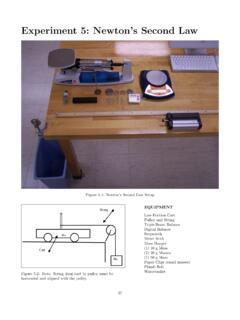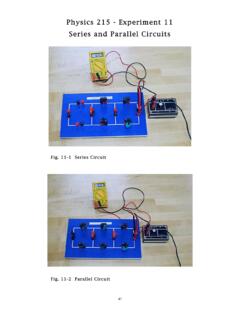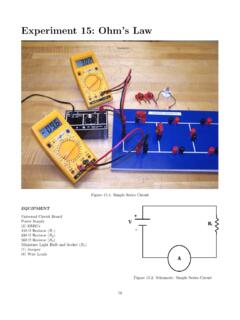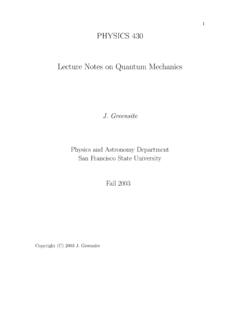Transcription of Experiment 12: Simple Harmonic Motion
1 Experiment 12: Simple Harmonic MotionFigure BallWood Ball(Note: sharp hooks)Meter StickDigital BalanceStopwatchPendulum Clamp and RodStringMasses: (2) 100g, (1) 50gMass HangerTable ClampProtractor12 Experiment 12: Simple Harmonic MotionAdvance ReadingText: Simple Harmonic Motion , oscillations, wave-length, frequency, period, Hooke s Manual: Appendix CObjectiveTo investigate Simple Harmonic Motion using a simplependulum and an oscillating spring; to determine thespring constant of a Motion is Motion of an object that regularlyreturns to a given position after afixed time inter-val. Simple Harmonic Motion is a special kind of peri-odic Motion in which the object oscillates sinusoidally,smoothly. Simple Harmonic Motion arises wheneveran object is returned to the equilibrium position by arestorative force proportional to the object s = kx( )The illustrative example above is Hooke s Law, whichdescribes the restorative force of an oscillating springof stiffnessk (spring constant).
2 For an ideal, massless spring that obeys Hooke sLaw, the time required to complete an oscillation (pe-riod,T, seconds) depends on the spring constant andthe mass,m, of an object suspended at one end:T = 2 mk( )The inverse of period is the frequency of that frequency,f, is the number of oscillationscompleted by a system every second . The standardunit for frequency is hertz, Hz (inverse second , s-1).The period of oscillation of an ideal, Simple pendulumdepends on the length,L, of the pendulum and theacceleration due to gravity,g:T = 2 Lg( )When setting the pendulum in Motion , small displace-ments are required to ensure Simple Harmonic displacements exhibit more complex, sometimeschaotic, Motion . Simple Harmonic Motion governswhere the small angle approximation is valid:Figure : Small Angle ApproximationThe arc length,s, of a circle of radiusr is:s =r ( )When is small, the arc length is approximately equalto a straight line segment that joins the two , the following approximations are valid: sin tan ( )Prelab 12: Simple Harmonic Motion3 Name:1.
3 Define Simple Harmonic Motion . What conditions must be met? (20 pts)2. What physical phenomenon does the relationshipT = 2 mkdescribe? (20 pts)3. What physical phenomenon does the relationshipT = 2 Lgdescribe? (20 pts)4. The following data were collected for Part 1 of the lab procedure. Complete the table. The force is due to thegravitational force. All distances are measured from the bottom of the hanger to the top of the stool. You shouldignore the initial weight of the hanger. Note that x is the change from initial position,xf x0, not the changefrom the previous position,x2 x1. (40 pts)Mass (g)Height (cm) x (m)Force (N) :Section:Date:Worksheet - Exp 12: Simple Harmonic MotionObjective:To investigate Simple Harmonic Motion using a Simple pendulum and an oscillating spring; to determinethe spring constant of a : Simple Harmonic Motion describes an object that is drawn to equilibrium with a force that is proportionalto its distance from equilibrium.
4 Such a restorative force will return an object to equilibrium after afixed timeinterval, regardless of where the object is placed. The time it takes for an oscillator to return the object to itsoriginal position is called the period of example of a Harmonic oscillator is a spring thatobeys Hooke s Law (F = kx). The period of an ideal,massless spring is related to the spring constant,k (orspring stiffness), and the mass of the object,m, thatit moves:T = 2 mkThe other Harmonic oscillator modeled in this experi-ment is the ideal Simple pendulum, whose period isrelated to its length,L, and the pull of gravity:T = 2 Lg1. A 6 kg bowling ball is hung from a spring of un-stretched length m. It stretches the spring m as shown. Find the spring constant of thisspring. (3 pts)k =N/m2. The restorative force of a pendulum is the part ofgravity that acts perpendicular to the pendulum arm:F = mg sin.
5 For small angles, this force is directlyproportional to displacement because sin . Toverify this, convert 20 to radians, then compute thesine of the angle. (5 pts) =sin =% Diff =By the small angle approximation, then, the pendu-lum behaves as a Simple Harmonic oscillator:F = (mg) .5 Procedure:Part 1: Spring Constant: Hooke s Law3. Hang the spring from the pendulum clampand hang the mass hanger from the the initial heightx0above Add 50 g to the mass hanger and determinethe change in position caused by this Add 50 g masses incrementally until 250 g hasbeen added to the mass hanger. Determinethe total displacement and the total addedweight with each additionAdded MassForce Applied x0 kg (hanger only)0 N0 m (x =x0)(15 pts)6. Generate a graph ofFvs. x using Graphical Analysis. Analyze the graph with a linearfit; print a copy for eachpartner and staple it to this datasheet. (6 pts)7. Does force vary directly with displacement?
6 Do we expect this system to undergo Simple Harmonic oscillation?(5 pts)8. What is the slope of the graph?What does the slope of this graph represent?(Hint: What value is obtained when two proportional quantities are related in this way?) (7 pts)6 Part 2: Spring Constant: Oscillation9. Measure the mass of the spring, mass hanger, and 100 g mass10. Hange the spring from the pendulum the mass hanger + 100 g from the Pull the mass hanger down slightly and release it to create small os-cillations. Measure the time required for 20 oscillations. (This is likemeasuring one period twenty times over.)Note: The spring used for thisexperiment is not ideal; its massaffects the period of for this by adding 1/3the mass of the spring to thevalue of suspended mass,m, inyour Calculate the period for the oscillating spring. (3 pts)T =13. Calculate the spring constant of the spring using your knowledge of the object s mass and period of your work.
7 (6 pts)k =14. a) Compare this spring constant (Step 13) to the slope found in Step 8. Are these values similar? (3 pts)b) What are some uncertainties involved when using the Hooke s law method? (5 pts)c) What uncertainties are involved with the oscillation method? (5 pts)7 Simple Pendulum15. Measure the mass of the metal (2 pts)16. Construct a Simple pendulum cm in length using the metal ball and some string. (L is measured from thecenter of mass of the ball)17. Move the pendulum from equilibrium (about 10 -20 ) and release it. Measure the time required for 20 Determine the period. Record it in the table =time required20cycles19. ShortenL in increments of cm and measureT for each Repeat the procedure using the wooden ball. Mass of the wooden (2 pts)Period of Oscillation:100 cm80 cm60 cm40 cm20 cm0 cmMetalWood(12 pts)21. Produce graphs for each ball. Apply a linearfit; printa copy for each partner (6 pts).
8 Squaring both sides of the simplependulum equation, it is apparent that the slope of graphshould be equal to 4 2/g. From the slopes of the graphs, calculateg. Show work. (10 pts)g(Graph)% ErrorMetalWood22. Consider the pendulums pictured at the right. Describe how one would de-termine how much more time pendulum A takes to travel a distance 2x thanfor pendulum B to travelx, given they have the same length. Assume thependulums are at rest at the positions in thefigures, then released. (5 pts)









